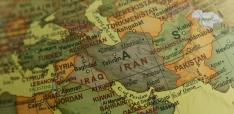Nuclear terror is back with a vengeance

In his monthly column, Alfredo Toro Hardy explains why the risk of nuclear war looks more ominous today than it did during the Cold War.
After the interlude brought over by the end of the Cold War, nuclear terror is back with a vengeance. Several reasons can attest why the situation is more ominous today than it was during the nuclear standoff between Americans and Soviets. First, nuclear parity between two fundamental actors is gone. Second, needed nuclear arms treaties are vanishing or yet inexistent. Third, the notion of first use of nuclear weapons has gotten laxer. Fourth, current rivalries between great powers materialize within their core geostrategic areas.
No parity
Firstly, nuclear arms parity is disappearing. According to the New START Treaty signed in April 2010, the number of nuclear weapons that both Russia and the United States could deploy was 1,550 each. This provided parity between them. Given that Russia suspended participation from this treaty in 2023, these numbers would increase. (Sciutto, 2024, p. 2015). Although for the time being Moscow would respect this limit, this has become simply optional. Meanwhile, China, which currently possesses around 500 operational nuclear warheads, is expected to double that amount by 2030 and to triple it by 2035. (Rahn 2024). Hence, in eleven years’ time Russia and China, two allies within the revisionist axis, would double America’s deployed nuclear warheads at current levels.
This provides the necessary conditions for a dangerous nuclear race, while distorting rational deterrence. As David E. Sanger puts it: “It was complicated enough during the Cold War to defend against one major nuclear power (…) now the United States would, for the first time in its history, have to think about defending against two major nuclear powers with arsenals roughly the size of Washington’s – and be prepared for the possibility that they might work together” (Sanger, 2024, p. 201). According to Thomas Schelling, the confrontation between two nuclear superpowers in parity conditions was tantamount to that of two far west’s gunfighters. (Fontaine, 2024). Uncle Sam, however, might have to simultaneously confront two gunfighters, each matching his own skills and fire power.
That was not the case during most of the Cold War, when nuclear parity prevailed. In the early 1970s, indeed, the Soviet Union attained relative nuclear parity with the United States, thus creating a state of strategic balance. Within it, each party possessed the capability to inflict similar and unacceptable damage to the other, thus imposing mutual restrain.
No treaties
Secondly, nuclear arms treaties are disappearing or have yet to be created. As mentioned before, the New START Treaty between Russia and the United States was suspended from compliance by Moscow. This treaty not only imposed limits on the number of nuclear warheads that each could deploy, but also on the number of deployable launchers and nuclear-capable bombers. Moreover, it allowed both nations to conduct inspections on the other to verify compliance. (Sciutto, 2024, p. 2016). For the time being, as said, Moscow would continue to abide by the numerical limits in the treaty. (Kirby, 2023). However, this becomes dependent on Russia’s good will and not in treaty obligations. Inspection activities, however, are off the table. Needless to say, without the New START agreement transparency disappears and each side is left to speculate and fear about the intentions of the other.
The New START was the last remaining U.S.-Russia nuclear arms control treaty, as the two other crucial arms control treaties disappeared before. In 2002, George W. Bush withdrew his country from the Anti-Ballistic-Missile (ABM) Treaty, while in 2019, Donald Trump did the same in relation to the Intermediate-Range Nuclear Forces (INF). As a result, all the big arms control treaties negotiated during the Cold War, or in its succeeding years, have elapsed, vanished or suspended. (Sciutto, 2024, p. 2014).
Meanwhile, no comprehensive agreement governing the nuclear weaponization of space has yet been put in place. This, as Russia develops a nuclear weapon specially designed to attack the satellites on which the U.S. military depends. According to James M. Acton: “The danger of spaced-based nuclear weapons isn’t just that Moscow might actually use them. It’s that Washington knows Moscow might actually use them. As a result, the United States might attack Putin’s space nukes before he can push the button – which in turn might incentivize Putin to jab his finger as fast as he can”. (Acton, 2024).
There is neither a nuclear arms control agreement between the U.S. and China. For a long time, Beijing was reluctant to. Finally, it decided to go forward, just to end negotiations on July of this year in protest for the U.S.’ arms sales to Taiwan. As a result, China has joined Russia in refusing to discuss nuclear arms control agreements with Washington. According to Reuters: “The Chinese decision comes just over a month after the Biden administration said the United States may have to deploy more strategic nuclear weapons to deter growing threats from Chinese and Russian arsenals” (Reuters, 2024).
Contrariwise, while the USSR existed, several nuclear arms treaties with the United States materialized. These included the Limited Test Ban Treaty of 1963, the Anti-Ballistic Missile (ABM) Treaty and the SALT I Agreement of 1972, the SALT II Agreement of 1979 (signed by not approved by the Senate as a result of the Soviet invasion to Afghanistan), the Intermediate-Range Nuclear Forces Treaty of 1987, and the Strategic Arms Reduction Treaty (START) of 1991. After the demise of the USSR in December of 1991, several additional treaties were put in place. This contractual framework helped in reducing uncertainty and mistrust.
Laxer notion
Thirdly, the notion of first use of nuclear weapons has gotten laxer. This applies, particularly, to Russia: Its military doctrine has changed several times in recent decades, becoming much more flexible in this regard. According to the U.S. Congressional Research Service: “This evolving doctrine seems to indicate that Russia has (…) placed a greater reliance on nuclear weapons and may threaten to use them during regional conflicts”. (Sciutto, 2024, p. 199).
Since 2022, indeed, the prospect of a tactical nuclear weapon’s detonation in Ukraine has become a regular feature. In September of that year Putin began raising the threat of a nuclear strike, which he reinforced in December, when saying: “Such a threat is growing, it would be wrong to hide it”. In January of the following year, it was Medvedev’s turn to say: “Nuclear powers do not lose major conflicts (…) This should be obvious to anyone”. In February of this year, Putin again threatened with the use of a nuclear strike if NATO send troops to Ukraine, while in September it announced that Russia was lowering the threshold for use of nuclear weapons. (United24 Media, 2024; AlJazeera, 2024).
This latitude in relation to the first use of nuclear weapons contrasts with the prevailing position during most of the Cold War. It is true that during Eisenhower’s time, when the U.S. enjoyed of overwhelming nuclear superiority, Washington seriously contemplated the use of nuclear weapons in several occasions. (Herring, 2008, p. 660). From Kennedy onwards, though, this ceased to be the case. Particularly, when the Soviet Union and the United States attained nuclear parity at the beginning of the 1970s. Under the concept of mutual assured destruction (MAD), in which each party had the ability to inflict unacceptable damage to the other in a retaliatory strike, the first use of nuclear weapons became an irrational option. (Diakov, Kadyshev and Podvig, 2000). Although Carter and Regan policies somehow distorted MAD, this notion remained in place until the end of the Cold War.
Core areas
Fourthly, current rivalries between great powers materialize in their core geostrategic areas, which increases the risk of nuclear war. This is the case in Ukraine, considered by Russia as fundamental to its national security and by NATO as fundamental for the preservation of the European one. However, the perception of core areas may be even higher with regard to China.
For Beijing, incorporating Taiwan to the People’s Republic relates to the “great rejuvenation” narrative that unifies the energy of 1,4 billion citizens, to the country’s “great unification” of its territory, and to the closing of the last loose end resulting from its “century of humiliation”. For China, this becomes an existential issue. Something similar, but to a lesser degree, happens in relation to the South China Sea: An area that for millennia was tributary to China’s power, and where the bloodstream of its economy passes today. Conversely, Taiwan remains an issue of the upmost importance for Washington if it wants to preserve its superpower reputation. Even more significant for the U.S. is safeguarding the freedom of navigation in the South China Sea, a key principle within the rules based liberal international order.
The above clearly differs with the prevailing situation during the Cold War. At the beginning of the 1950s, Stalin understood that searching for new European preys beyond the Iron Curtain entailed the risk of a direct confrontation with the Americans. As a result, Soviet expansionism moved away from this red area. Conversely, in 1956 rebellious Hungarians turned against their Soviet puppet regime. When the Kremlin sent the Red Army to restore order, it was met by a brave popular resistance that with Molotov cocktails in hand ran the soviets out of Budapest. This seemed as the perfect moment for the U.S. to intervene. However, Eisenhower decided to respect the Iron Curtain’s boundary, and abstained from meddling in. Hence, both parties respected the red lines of the other, greatly reducing the risk of a direct confrontation. The only exception came by the adventurous positioning of Soviet nuclear missiles in Cuba, 70 miles’ away from American mainland. This almost led to a nuclear confrontation in 1963 (Dailey, 2018, pp. 243, 244).
In sum, the risk of nuclear war seems greater today than it did during the decades of the Cold War between Soviets and Americans.
Alfredo Toro Hardy, PhD, is a retired Venezuelan career diplomat, scholar and author. Former Ambassador to the U.S., U.K., Spain, Brazil, Ireland, Chile and Singapore. Author or co-author of thirty-six books on international affairs. Former Fulbright Scholar and Visiting Professor at Princeton and Brasilia universities. He is an Honorary Fellow of the Geneva School of Diplomacy and International Relations and a member of the Review Panel of the Rockefeller Foundation Bellagio Center.
Photo by Estonian Stalker
References
Acton, James M. (2024). “Space Nukes are Bad”. Carnegie Endowment for International Peace, October 8.
AlJazeera (2024). “Putin outlines new rules for Russian use of vast nuclear arsenal”. September 26.
Council on Foreign Relations (2024). “U.S.-Russia Nuclear Arms Control”.
Dailey, J. (2018). Building the American Republic (Vol.2). Chicago: The University of Chicago Press.
Diakov, Anatoly, Kadyshev Timur and Podvig, Pavel (2000). “Nuclear Parity and National Security in New Conditions”. Center for Arms Control, Energy and Environmental Studies, The PIR Study Papers, Number 14, May.
Fontaine, Phillipe (2024). “Commitment, Cold War, and the battles of self: Thomas Schelling on Behavior Control”. Journal of the Behavioral Sciences, April.
Herring, George C. (2008). From Colony to Superpower. Oxford: Oxford University Press.
Kirby, Jen (2023). “The last US-Russia arms control treaty is in big trouble”. Vox, 25 February.
Rahn, Welsey (2024). “China’s nuclear weapons a growing concern for the US”. Deutsche Welle, August 29.
Reuters (2024). “China says it has halted arms-control talks with US over Taiwan”. July, 17.
Sanger, David E. (2024). New Cold Wars. New York: Crown Publishing Books.
Sciutto, Jim (2024). The Return of Great Powers. New York: Dutton.
United24 Media (2024). “A Timeline of Russia’s Nuclear Threats Against the West”, June 27.


